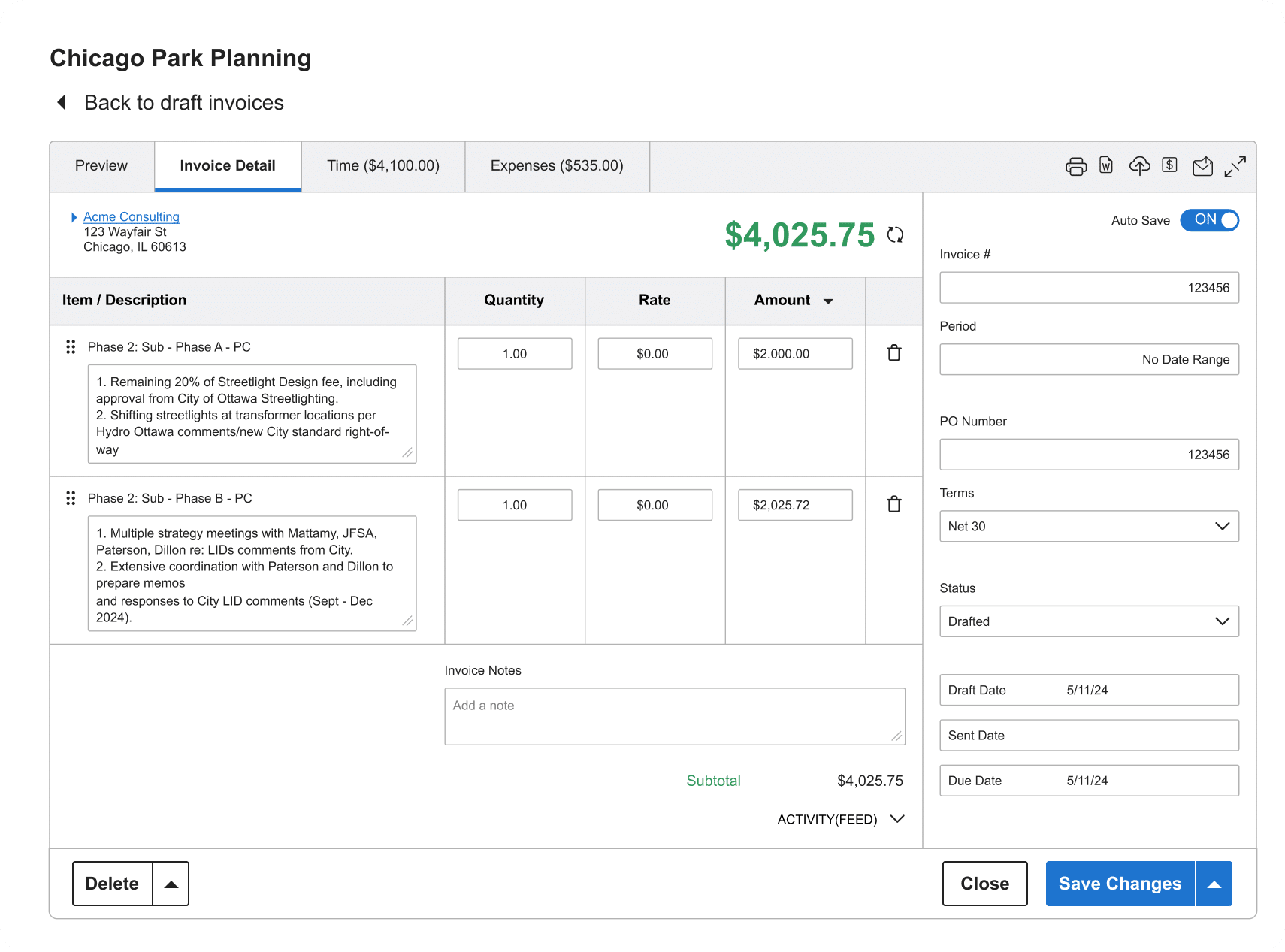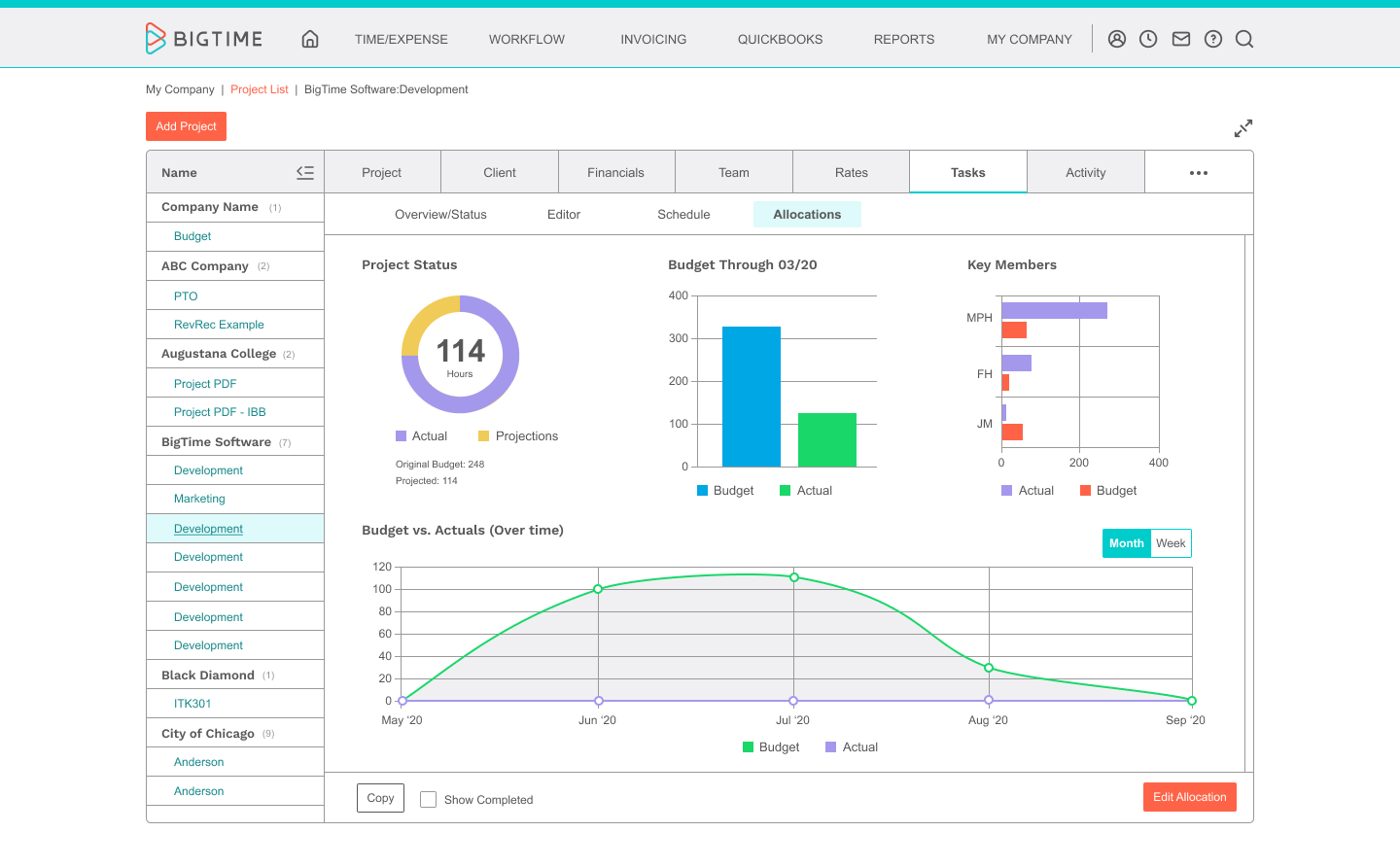Billing System Software
BigTime's billing system software helps simplify your billing and strengthen your cash flow with tools specifically built for professional services firms.
Why Choose BigTime’s Billing System Software?
Manual billing processes can be time-consuming, error-prone, and a major roadblock to healthy financial operations. If you're still wrestling with spreadsheets, delayed payments, or manual data entry, it’s time for a smarter solution.
BigTime’s billing and invoicing software is designed specifically for professional services firms. It streamlines your billing process, reduces late payments, and improves cash flow through automation and seamless integration with your accounting software. With BigTime, you’ll easily create branded invoices, accept payments online, and stay compliant—all while saving time and improving customer satisfaction.
Tailor billing to industry
BigTime is specifically built for professional services firms.
Get paid faster
Automate invoicing and collections to reduce payment delays.
Customize your invoices
Deliver professional invoices that reflect your firm’s identity.
Use the tools you love
Sync effortlessly with accounting software such as QuickBooks and Xero.
Enhance accuracy
Ensure every billable hour is captured without revenue leakage.
Improve client experience
Offer secure and flexible payment options for easy transactions.
Tailor Billing to Professional Services
BigTime isn’t just another billing software solution—it’s tailored for the unique needs of accounting, architecture, consulting, IT, and engineering firms. Whether you bill hourly, per project, or use recurring billing, BigTime adapts to your workflow.
Our platform supports industry-specific billing models and gives your team the tools to handle services rendered efficiently without extra admin overhead or manual processes.
Get Paid Faster
Send invoices automatically with integrated payment processing to reduce billing cycles and accelerate cash flow. BigTime helps you stay ahead of due dates and eliminates the need to follow up with manual payment reminders, increasing overall efficiency.
Clients can pay directly via credit card, ACH, or other payment options, making it easier for you to get paid quickly and efficiently.
Customize Your Invoices
Deliver professional invoices that reflect your firm’s identity. BigTime allows you to design fully customizable invoice templates, complete with your logo, colors, detailed line items, and custom fields.
You can set different billing rates for projects, clients, or team members, ensuring financial transparency and accurate billing simultaneously.

Use the Tools You Love
BigTime syncs effortlessly with QuickBooks Online, Sage Intacct, and other platforms. This eliminates manual data entry and ensures consistency across your financial management software.
Working with your existing tools also means your team doesn't have to learn new systems—just smarter ways to use the ones they already love.
Enhance Accuracy and Compliance
Reduce costly errors with automated billing software that captures time, expenses, and approvals in real time. You’ll no longer risk billing the wrong amount or missing key information.
Plus, multi-level approval workflows ensure that invoices are reviewed and approved before being sent—keeping your firm compliant and your clients happy.
Improve Client Experience
Clients appreciate clarity. BigTime offers a client portal where customers can view, pay, and track their invoices anytime. Clear breakdowns of charges, convenient online payments, and automatic updates improve transparency and boost customer satisfaction.
Better billing starts here.
free trial
Key Features of BigTime’s Billing System Software That Take the Pain Out of Billing
BigTime’s robust billing features help businesses save time and optimize every step of the invoicing process. Here’s how we transform your billing operations from a bottleneck into a competitive advantage.
Flexible Billing Rates
Multi-Level Approval Workflows
Payment Processing Integration
Work-in-Progress (WIP) Management

A/R Aging Reports
Secure Client Portal Access
How BigTime Billing Software Works: Simple, Secure, and Efficient
BigTime is more than simple billing and invoicing software—it’s a streamlined project management engine that automates your entire process from tracking time to collecting payment.
Step 1: Time & Expense Tracking
Step 2: Invoice Creation
Step 3: Invoice Approval
Step 4: Client Delivery
Step 5: Payment Collection
Why Professional Services Firms Choose BigTime
Success Story: Real Results for Real Firms
With BigTime, Hakkoda streamlined its invoicing operations and improved accuracy in accounts receivable. The result? Better financial oversight and faster payments. Read the full story.
What Our Customers Say


Corey Ariss


Jay Shewan


Eryn White
FAQ
What is billing system software?
Billing system software automates the creation, delivery, and management of invoices. It helps you track billable time, reduce errors, and collect payments faster.
How does billing system software help professional services firms?
BigTime’s software supports time and billing models common in service industries. It automates tasks, integrates with your accounting software, and ensures every dollar of services rendered is accurately invoiced.
Can BigTime integrate with my existing accounting tools?
Yes, BigTime seamlessly integrates with QuickBooks Online, Sage Intacct, and other financial management software and business tools—ensuring accurate reporting and no double entry.
How does BigTime support different billing structures?
As a modern billing software, BigTime supports time and materials, fixed-fee, and recurring billing models. You can also create hybrid models that suit client preferences.
Is invoice customization possible?
Absolutely. Create custom invoice templates with your logo, line-item details, taxes, and payment terms.
Does BigTime offer automated invoice approvals?
Yes. Multi-level approval workflows ensure every invoice is checked and approved before it goes out, reducing manual processes and errors.
Can I track overdue payments?
Yes. BigTime provides A/R aging reports and automated payment reminders to help you manage and collect late payments.
Is multi-currency invoicing supported?
Yes, you can bill in multiple currencies and track conversions for accurate international financial operations.
Can clients pay directly through BigTime?
Yes. Integrated payment options like credit card and ACH let clients accept payments right from the invoice.
How secure is BigTime’s billing system software?
We use bank-level encryption and industry compliance protocols to keep all sensitive financial data and payment information safe.
Does BigTime provide analytics and reporting?
Yes. Robust reporting dashboards track billing performance, profitability, and cash flow.
Is BigTime cloud-based?
Yes. As a cloud-based solution, BigTime lets you access your data and send invoices from anywhere, anytime.
Can I set different billing rates for staff or tasks?
Yes. You can set unique billing rates by employee, project, or role, giving you full control and billing transparency.